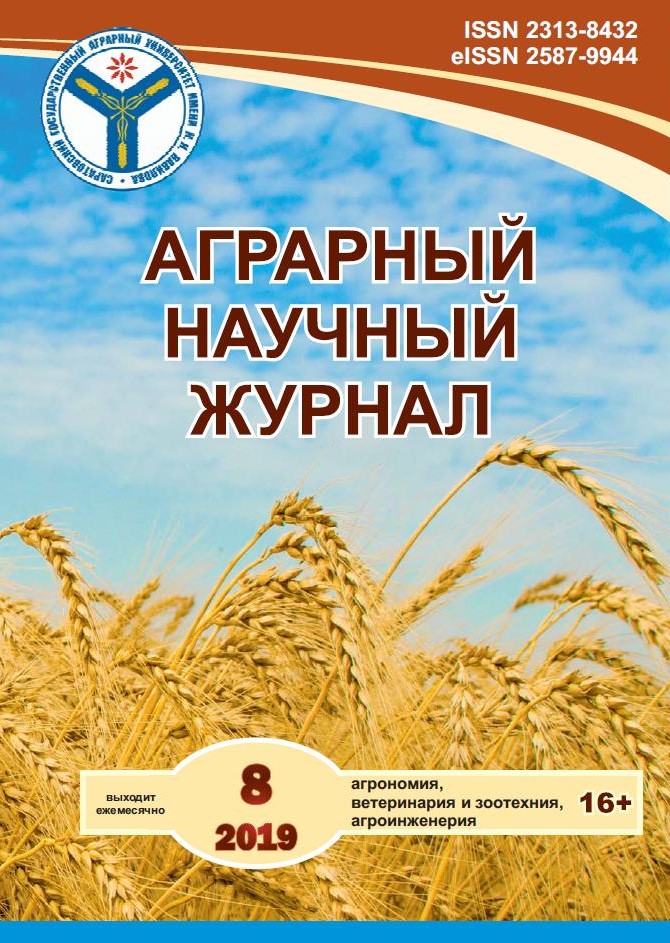Features of accumulation of the technogenic radionuclides in meat of some hunting animals in the Trans-Urals
DOI:
https://doi.org/10.28983/asj.y2019i8pp47-52Keywords:
hunting animals, forest biotopes, technogenic radionuclides, radiometric analysis, radioactivity of meatAbstract
The degree of contamination of the organism of wild animals with radionuclides is of particular importance in the framework of environmental monitoring and assessment of its safety, both for humans and for animals. However, the majority of domestic scientific works on this subject concerns farm animals, and the information relating to hunting animals is much less. This fact determined the relevance of our work, the purpose of which was to study the features of the accumulation of global technogenic and natural radionuclides in the meat of some wild animals in the TRANS-Urals. Experimental data on the content of technogenic radionuclides in the meat of hunting animals were obtained in the autumn-winter periods of 2014 – 2018. Analysis of the average data showed, that the content in the meat of wild animals cesium-137, depending on the animal species, ranged from 4.1 to 49.2; lead-210 – 0,7 – 4,3; and strontium-90 – 0,1 – 1,7 Bq/kg. The total beta- activity of radionuclides in the meat of wild animals varied, depending on the species, from 71.2 to 104.3 Bq/kg. At the same time, all the studied samples of meat corresponded to the norms established by SanPiN-2010 for this type of food product. Some increased accumulation of radioactive cesium (49.2 Bq/kg) and other anthropogenic radionuclides was observed in wild reindeer meat, and in the southern regions of the TRANS-Urals – in bear and wild boar meat (21.1 and 17.4 Bq/kg, respectively). In the muscle tissue of the roe deer the content of this radionuclide was slightly higher than that of the elk (14.7 and 12.2 Bq/kg, respectively). The lowest concentration of cesium-137 (4.1 Bq/kg) and other nuclides was found in beaver meat. The content of strontium-90 in the meat of all tested animals was at a minimum level, and the specific activity of lead-210 was higher than strontium-90 by 2 - 10 times, depending on the species, which indicates the accumulation of this radionuclide in forest ecosystems due to anthropogenic pressure and expansion of the technogenic zone of cities. The results of studies have shown that differences in the accumulation of technogenic radionuclides in the meat of the hunting animals are largely related to the nature of feeding and composition of the diet of wild species, and are subject to significant fluctuations in accordance with the change in the volume and qualities of food resources in forest biotopes over the year.
Downloads
References
2. Окунев А.М. Особенности перехода техногенных радионуклидов из рациона в молоко и мясо коров при пастбищном содержании на юге Тюменской области// Вестн. КрасГау, 2018. – № 6. – С. 250 – 254.
3. Максимюк Н.Н. Исследование содержания ксенобиотиков в мясе диких кабанов// Международный научно-исследовательский журнал, 2008. – № 7(38). – С. 81 -84.
4. Андриянова Ю.М., Сергеева И.В., Гусакова Н.Н., Мохонько Ю.М. Получение экологически безопасной зерновой продукции на антропогенно-загрязненных территориях Саратовской области // Аграрный научный журнал. – 2016. – No 3. – С. 8–13.
5. Демина Э.А. Модификация цитогенетических эффектов, индуцированных радиацией в малых дозах// Тезисы докладов IV международной конференции «Хроническое радиационное воздействие: Эффекты малых доз». – Челябинск, 2010. – С.112 – 114.
6. Михалусев В.И. Радиоэкологический мониторинг диких млекопитпющих в зоне радиоактивного загрязнения// Проблемы радиологии загрязненных территорий. Юбилейный тематический сборник. – Минск, 2001. – Вып.1. – С. 154 – 174.
7. Гигиенические требования безопасности и пищевой ценности пищевых продуктов// СанПиН 2.3.2.2650 - 10. – М.: ФГУП «ИнтерСЭН», 2010. – 168 с.








